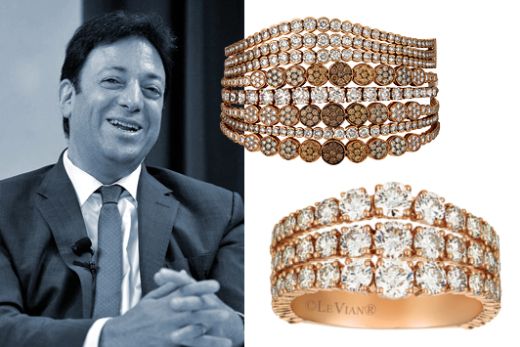|
|
Le Vian Embraces Role as Sector Trendsetter
Jeweler sees its forecasting work as vital to the industry’s survival.
Jan 24, 2019 5:41 AM
By Avi Krawitz
|
|
|

RAPAPORT... Eddie Levian has an air of confidence as he navigates Le
Vian’s large and loud booth at the JCK Luxury show in Las Vegas. With music
blaring in the background, he stops mid-sentence during our interview about the
jewelry brand’s latest collection to focus on his retail partners.
“If everyone could send a happy birthday message to my
brother, who couldn’t be with us at the show this year,” he announces with an
awkward ease and his famously assuring smile. The room full of mainly
independent retailers responds warmly, eager to fuel the sense of family the
Levians consciously champion.
The independents, after all, are generally family-owned
businesses and therefore have the same mentality as Le Vian, the company CEO
says. “They embrace us because we treat them as part of the family. It’s a
different way of looking at business.”
That message provided reassurance over the years as Le Vian
grew and started distributing to the multi-store chains. For a time, the
independents were concerned they couldn’t compete with the larger companies if
they carried the same brand, Levian recalls. Creating exclusive collections and
marketing for the independents helped alleviate those fears — and it was no
small task, given that Le Vian is available today at some 3,800 stores across
the US.
Going by the book
Levian understands his job is to innovate. The company
presents approximately 40,000 new designs each year, aiming to supply different
collections to a wide variety of customers.
Much of that product development is organized into the
brand’s annual trend book, which is unveiled each year at its glitzy Le Vian
Red Carpet Revue during the Las Vegas show in early June. The event offers core
retail vendors a first glimpse of the 2019 collection so they can have the
pieces in store when Le Vian rolls out its marketing program to the public. The
trend book is then translated into individual pieces to fit each retailer’s
needs, Levian says.
But there’s a greater purpose as well: Levian sees the
annual forecast as an important tool for positioning the company as a
trendsetter in the jewelry market.
“It’s not just a fashion show,” he stresses. “It’s a driving
force for the industry, because other jewelers are motivated by the trends we
bring.”
How to sell beauty
This is a role Levian is happy to fill; unlike the fashion
industry, he suggests, the jewelry trade lacks a united voice that can push a
trend and stimulate demand.
Le Vian’s predictions are largely informed by the company’s
observations of collectors at the 3,500 or so one-day shows it hosts across the
US each year, as well as its experience dressing celebrities. The company also
keeps tabs on the mining sector so it knows what new and interesting gemstones
are available.
A case in point is Peacock Aquaprase, which the brand
introduced this fall. It was in response to a request by the fashion editors at
Harper’s Bazaar that Le Vian scoured its contacts in the gem world for
something in grey, and the new stone, discovered by geologist Yianni Melas, was
the result.
But it’s keeping in touch with fashion that Levian believes
gives his company an extra edge. Tapping the fashion world enables it to look
at diamonds from a female-centric viewpoint, he explains. It’s what motivated
the company’s choice of Nude diamonds as its diamond of the year and the “Nude
Palette” as its color trend for 2019. Levian observes that women shop for
jewelry the same way they do for makeup, lingerie or general fashion.
“The collection is a range of skin tones, from nude to
chocolate diamonds,” he notes. “Matching colors to skin tone is the way beauty
is sold today.”
He emphasizes that jewelry needs to be viewed as part of the
fashion world, especially as it shifts its marketing focus toward women rather
than selling engagement rings to men. The dynamic of the man being the core
consumer while women are the collectors needs to change, as women are more
financially independent today, he argues. After all, the genders experience the
world in different ways, and that plays out in the jewelry market.
For instance, he explains, men want to be the hero who buys a
beautiful piece for the woman, so they’ll typically go for a classic solitaire
diamond that she’ll wear for the next 20 or 50 years. Meanwhile, women are
immersed in a world of mass design but still view themselves as unique. Jewelry
helps a woman express her individuality and show that she’s up on the latest
trends, but the guy — who in the past has been the target market for
diamond-buying — is looking for a conservative piece.
It’s a difficult dynamic that doesn’t bode well for the
survival of the industry, Levian cautions. And it’s a challenge he believes his
brand can overcome, as it can target both sets of consumers through the trend
forecast.
“The stores need their jewelry to be in fashion so that the
woman can get something new every season and so that the guy can feel safe to
be the hero when he buys something for her,” he explains. “The acceptance by
the consumer that this is the trend of the year is the key to our success.”
This article was first published in the January 2019 issue of Rapaport Magazine.
Image: Eddie Levian, alongside two of his company’s designs. (Le Vian)
|
|
|
|
|
|
|
|
|
|
Tags:
Avi Krawitz, Eddie Levian, JCK Luxury show in Las Vegas, le vian, Le Vian Red Carpet Revue, Peacock Aquaprase, Yianni Melas
|
|
|
|
|
|
|
|
|
|
|

|
|